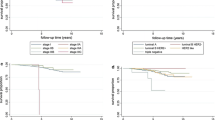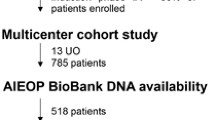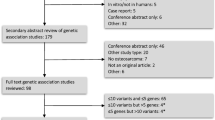Abstract
Taxanes have resulted in improved survival for breast cancer patients, but often cause neurological toxicities. Identification of biomarkers related to toxicities could be important for dictating treatment regimen. We evaluated single nucleotide polymorphisms (SNPs) in the Fanconi Anemia (FA)/BRCA pathway in relation to grade 3/4 neurotoxicities in patients (n = 888) from SWOG0221, a phase III adjuvant trial for breast cancer of 4 dose/schedules of cyclophosphamide (C), doxorubicin (A), and paclitaxel (T). In a separate cohort, we measured the correlation of significant FANCD2 SNPs with corresponding gene expression. For FANCD2, permutation testing revealed that 4 (out of 20) SNPs were significantly associated with an almost two-fold increased risk of toxicity. Two FANCD2 haplotypes were also associated with neurological toxicity, with odds ratios (OR) in the overall population of 1.8 (95% confidence interval (CI) 1.3, 2.5) and 1.7 (95% CI, 1.2, 2.4). Although numbers were small, an African-American-specific haplotype was associated with an almost 3-fold increase in risk of neurologic toxicity (OR = 2.84, 95% CI = 1.2, 6.9). Expression analyses revealed that significant FANCD2 SNPs were associated with FANCD2 expression levels (P = 0.03). There were no associations between SNPs in BRCA1 and neurotoxicities. In this trial of CA+T for breast cancer, SNPs in FANCD2, but not in BRCA1, were associated with a 70–80% increase in the odds of grade 3/4 neurological toxicities and increased expression of the gene. If replicated, women with these genotypes should be closely monitored for toxicities and could be targeted for preventive measures or alternative therapeutic approaches.



Similar content being viewed by others
References
Henderson IC, Berry DA, Demetri GD, Cirrincione CT, Goldstein LJ et al (2003) Improved outcomes from adding sequential Paclitaxel but not from escalating Doxorubicin dose in an adjuvant chemotherapy regimen for patients with node-positive primary breast cancer. J Clin Oncol 21:976–983
Mamounas EP, Bryant J, Lembersky B, Fehrenbacher L, Sedlacek SM et al (2005) Paclitaxel after doxorubicin plus cyclophosphamide as adjuvant chemotherapy for node-positive breast cancer: results from NSABP B-28. J Clin Oncol 23:3686–3696
Martin M, Pienkowski T, Mackey J, Pawlicki M, Guastalla JP et al (2005) Adjuvant docetaxel for node-positive breast cancer. N Engl J Med 352:2302–2313
Roché H, Fumoleau P, Spielmann M, Canon JL, Delozier T et al (2006) Sequential adjuvant epirubicin-based and docetaxel chemotherapy for node-positive breast cancer patients: the FNCLCC PACS 01 Trial. J Clin Oncol 24:5664–5671
Perez EA (2005) TAC—a new standard in adjuvant therapy for breast cancer? N Engl J Med 352:2346–2348
Lee JJ, Swain SM (2006) Peripheral neuropathy induced by microtubule-stabilizing agents. J Clin Oncol 24:1633–1642
McGrogan BT, Gilmartin B, Carney DN, McCann A (2008) Taxanes, microtubules and chemoresistant breast cancer. Biochim Biophys Acta 1785:96–132
Wang RH, Yu H, Deng CX (2004) A requirement for breast-cancer-associated gene 1 (BRCA1) in the spindle checkpoint. Proc Natl Acad Sci USA 101:17108–17113
Branham MT, Nadin SB, Vargas-Roig LM, Ciocca DR (2004) DNA damage induced by paclitaxel and DNA repair capability of peripheral blood lymphocytes as evaluated by the alkaline comet assay. Mutat Res 560:11–17
Dalton WB, Nandan MO, Moore RT, Yang VW (2007) Human cancer cells commonly acquire DNA damage during mitotic arrest. Cancer Res 67:11487–11492
Swanton C, Nicke B, Schuett M, Eklund AC, Ng C et al (2009) Chromosomal instability determines taxane response. Proc Natl Acad Sci USA 106:8671–8676
Quinn JE, Kennedy RD, Mullan PB, Gilmore PM, Carty M et al (2003) BRCA1 functions as a differential modulator of chemotherapy-induced apoptosis. Cancer Res 63:6221–6228
Kennedy RD, Quinn JE, Mullan PB, Johnston PG, Harkin DP (2004) The role of BRCA1 in the cellular response to chemotherapy. J Natl Cancer Inst 96:1659–1668
D’Andrea AD, Grompe M (2003) The Fanconi anaemia/BRCA pathway. Nat Rev Cancer 3:23–34
Kennedy RD, D’Andrea AD (2005) The Fanconi Anemia/BRCA pathway: new faces in the crowd. Genes Dev 19:2925–2940
Venkitaraman AR (2004) Tracing the network connecting BRCA and Fanconi anaemia proteins. Nat Rev Cancer 4:266–276
Huen MS, Sy SM, Chen J (2010) BRCA1 and its toolbox for the maintenance of genome integrity. Nat Rev Mol Cell Biol 11:138–148
McShane LM, Altman DG, Sauerbrei W, Taube SE, Gion M et al (2005) Reporting recommendations for tumor marker prognostic studies (REMARK). J Natl Cancer Inst 97:1180–1184
Gabriel SB, Schaffner SF, Nguyen H, Moore JM, Roy J et al (2002) The structure of haplotype blocks in the human genome. Science 296:2225–2229
Tsai HJ, Choudhry S, Naqvi M, Rodriguez-Cintron W, Burchard EG et al (2005) Comparison of three methods to estimate genetic ancestry and control for stratification in genetic association studies among admixed populations. Hum Genet 118:424–433
Werness BA, Ramus SJ, DiCioccio RA, Whittemore AS, Garlinghouse-Jones K et al (2004) Histopathology, FIGO stage, and BRCA mutation status of ovarian cancers from the Gilda Radner Familial Ovarian Cancer Registry. Int J Gynecol Pathol 23:29–34
Pritchard JK, Stephens M, Donnelly P (2000) Inference of population structure using multilocus genotype data. Genetics 155:945–959
Huang HQ, Brady MF, Cella D, Fleming G (2007) Validation and reduction of FACT/GOG-Ntx subscale for platinum/paclitaxel-induced neurologic symptoms: a gynecologic oncology group study. Int J Gynecol Cancer 17:387–393
Wang W (2007) Emergence of a DNA-damage response network consisting of Fanconi anaemia and BRCA proteins. Nat Rev Genet 8:735–748
Chen CC, Taniguchi T, D’Andrea A (2007) The Fanconi anemia (FA) pathway confers glioma resistance to DNA alkylating agents. J Mol Med 85:497–509
Acknowledgments
This study was supported by National Institute of Health (NIH) R01 CA116395, and the following PHS Cooperative Agreement grant numbers awarded by the National Cancer Institute, DHHS: CA32102, CA38926, CA63844, CA63845, CA 20319, CA46282, CA46441, CA35261, CA63848, CA67575, CA14028, CA35281, CA128567, CA45560, CA58882, CA13612; CA46368, CA45808, CA58658, CA76447, CA37981, CA04919; CA95860; CA27057, CA42777, CA22433, CA74647, CA86780, CA68183, CA58861, CA45807, CA35192, CA35178, CA58416, CA35176, CA67663, CA35431, CA12644, CA16385, CA11083, CA45377, CA35128, CA35262, CA52654, CA76429, CA58723, CA46113, CA76132, CA45450, CA35119, CA45461, CA21115, CA21076, CA77597, CA25224, CA77202, CCSRI 15469, and in part by Amgen, Inc. The Roswell Park Cancer Institute (RPCI) Genomics Core Facility is a CCSG Shared Resource (NIH P30 CA016056-27). Support was also provided by the Fashion Footwear Charitable Foundation of New York/QVC Presents Shoes on Sale ™ (DFH) and Drs. Ambrosone, Gralow, Hayes, Hershman, and Hortobagyi are recipients of funding from the Breast Cancer Research Foundation. Funding agencies had no involvement in the study design, data collection, analysis and interpretation, or in the writing of the report and submission. We acknowledge and thank Dr. Frank L. Meyskens, Jr., M.D., Associate Chair for the Cancer Control & Prevention Committees of the Southwest Oncology Group, for his administrative support.
Author information
Authors and Affiliations
Corresponding author
Rights and permissions
About this article
Cite this article
Sucheston, L.E., Zhao, H., Yao, S. et al. Genetic predictors of taxane-induced neurotoxicity in a SWOG phase III intergroup adjuvant breast cancer treatment trial (S0221). Breast Cancer Res Treat 130, 993–1002 (2011). https://doi.org/10.1007/s10549-011-1671-3
Received:
Accepted:
Published:
Issue Date:
DOI: https://doi.org/10.1007/s10549-011-1671-3




